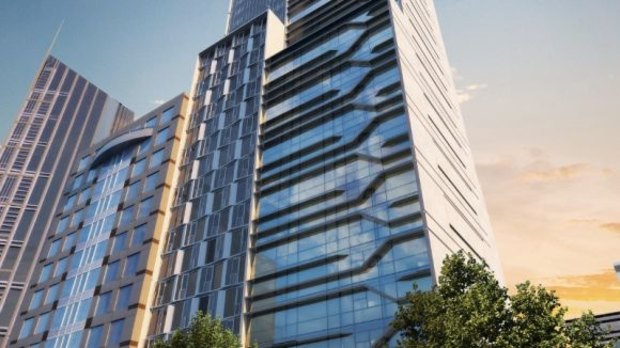This was published 8 years ago
Hickory Group gains partial approval for night work on Melbourne tower
By Philip Hopkins
Hickory Group has received conditional approval to start building an innovative, prefabricated, 44-storey residential tower in the Melbourne CBD.
The project will help make Victorian construction industry history.

An artist's impression of La Trobe Tower.
However, the ground-breaking plan to assemble the tall building on-site from various parts faces a hiccup: a move to work at night has prompted concerns from local residents about construction noise.
The Melbourne City Council will let Hickory undertake limited activities during a trial period at 323 La Trobe Street. Those activities will be reviewed before the work proceeds.
However, Hickory's prefabrication approach – a state government discussion paper released last week points out – is the key to increasing productivity in the $21.6 billion Victorian construction industry.
Hickory managing director Michael Argyrou said the hybrid building would use prefabricated elements that would halve the construction time compared with conventional methods.
"Our construction methodology involves integrating elements such as sub-assembled bathrooms, precast concrete panels and pre-attached building facades," he said.
Prefabricated construction is used by big developers such as Lend Lease, Mirvac and Australand.
However, Hickory's tower would take the process a step further.
The discussion paper, prepared by the Department of Economic Development, Jobs, Transport and Resources, also notes that prefabrication offers lower costs and reduced project payback times and waste, while improving workplace safety.
It also boosts productivity by driving production efficiencies, automation and advanced manufacturing techniques and complex systems thinking. On the site, it also reduces the work time lost because of bad weather.
The paper notes an earlier Hickory project – the four-storey, 128-room Bendigo Hospital project hotel – was assembled in six days. The parts were manufactured in Melbourne and put together on the site by a small assembly team using a 200-tonne crane.
"Off-site construction is more widely used in Europe and North America and is becoming more common in some Asian markets," the paper says.
In Australia, the uptake was about 3 per cent of all starts.
"Some commentators predict that over the next 10 years, up to 15 per cent to 25 per cent of new building in Australia will be prefabricated or modular construction.
"[However], a lack of understanding around off-site construction, particularly by regulators, educators and financiers is limiting the sector's development."
The paper urges that Victoria establish itself as the nation's centre of excellence in off-site construction, both commercially and as a prefabrication skills centre.
While the technology offers the prospect of new export markets, import competition is a threat, the paper says.
One commentator warned that prefabricated imports into Australia could be valued at $30 billion by 2025 and cost about 75,000 jobs nationally.
The various aspects surrounding prefabrication will be discussed at the prefabAUS conference at the University of Melbourne from September 14 to 16.